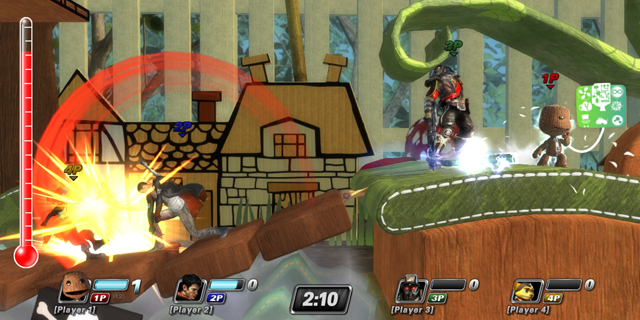
While games derivative of Nintendo’s unfathomably-successful Super Smash Bros. are nothing new (though largely Japan-exclusive; shoutouts to Dream Mix TV World Fighters and Battle Stadium D.O.N.), PlayStation All-Stars Battle Royale is the first time a major developer has stepped up to the plate in an attempt to deliver some serious Street Fighter II/Fatal Fury-level competition to the legendary party brawler.
All-Stars goes to great lengths to capture the polished mechanical feel and crossover fanservice majesty of Smash, while simultaneously distancing itself as much as it possibly can. This result is something that Internet commentators will vehemently denounce as a rip-off, but in reality is a strong contender that, while rough around the edges, will potentially deliver a hardy kick in the pants to a relatively young genre that faces the risk of stagnation.
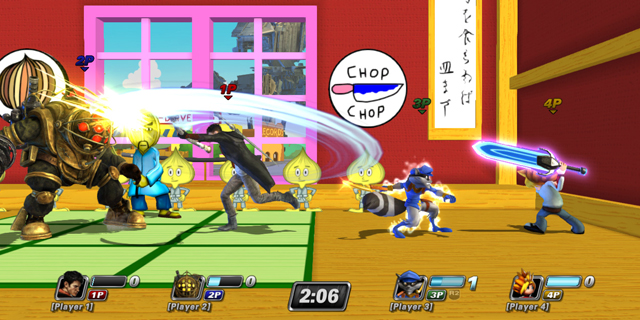
One of the coolest things about Battle Royale is how thoroughly Sony and developer SuperBot make use of not only their roster of characters, but the PlayStation brand itself in the world of their game. Several references of the standard PlayStation XMB theme are made throughout the game, characters explode into the shapes on the PlayStation face buttons when defeated and a long-forgotten mascot makes an appearance. It makes for a surprisingly-neat aesthetic that really shows how enthusiastic the folks that made the game were during development.
However, as great as this may be, it also makes something that is missing stand out that much more: meaningful unlockable content. The large audiovisual presence of the PlayStation brand throughout the game leads one to think that all manner of unlockable goodies celebrating the PlayStation legacy would be on the table, but that isn’t the case.
You can unlock backgrounds and icons for your online profile for online play, but other than that you can get one alternate costume per character, as well as unique victory music (something that baffles me as an unlockable) and different entrance and victory poses. Considering the fact that one of the things about Smash that sets it far and apart from its rivals is the smattering of historic unlockable bonuses that pay tribute to the decades of history behind the characters, the lack of such things in its biggest competitor is undoubtedly its biggest disappointment.
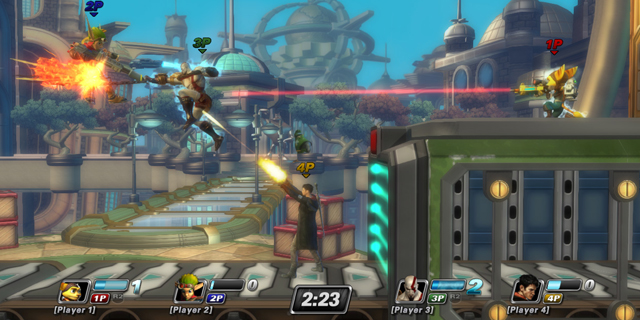
Mechanically, All-Stars especially stands out in its expansion upon the usual four-player brawler format. At first glance, it seems typical, and especially derivative of Smash. The characters are small compared to their surroundings, swiftly and fluidly scoot about the stages, roll for evasion and have single-button multidirectional attacks. What the game offers that sets it apart from the herd is options.
Traditionally these kinds of games, reminiscent of what you’d find (oddly enough) in most anime fighters, feature a two-button attack system. One button corresponds to physical attacks, and another makes use of whatever special powers your chosen fighter has at their disposal. All-Stars bucks that trend, by using all three of the face buttons (X is used to jump) and giving each button its own unique and usable sets that usually have their own situational uses (though some can seem like filler more than anything else), but most importantly add variety to the combat and give the player almost as many options as a more hardcore fighter might. This adds more depth than expected to the combat in terms of combo potential and the coming metagame.
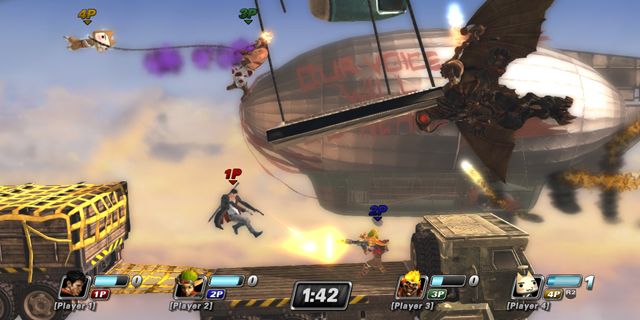
When you get to the super move system is when things start to get rocky. The only way to score points in All-Stars is to build meter, in the form of damage and AP orbs that present themselves for various reasons, and unleashing one of three of a character’s super moves depending on how much meter you have when you pop it. This, to me, breaks what would normally be a pretty well-balanced game for multiple reasons.
One, it really messes with the pacing of matches, especially when you aren’t playing a four-player free-for-all. Games tend to drag, especially in one-on-one and two-versus-two matches, since the fighting is less chaotic which leads to more calculated actions and less opportunities for risk-taking. One-on-one matches in particular can take forever (especially in stock mode), as the two combatants continuously pummel each other while managing to dodge the slower and generally easy to avoid super moves. Timed matches are similar, but unless the match is particularly one-sided, the overall scoring is going to be very low. It just stops being exciting after a while.
Secondly, all of these super moves are unblockable, and in the case of level threes, unavoidable, which cheapens victories, especially in free-for-all mode. One may argue that the race to build meter takes the place of something closer to a traditional life bar or other K.O. methods, but it doesn’t take much time to get to level one, and it isn’t that difficult to line up at least one kill each super during the chaos. Taking the time to build up to your level three, as long as you can play keep away well enough, can lead to a sure victory.
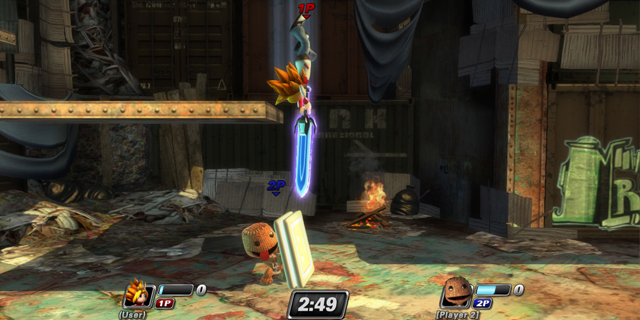
Third, while the characters and their general movesets are pretty well balanced, the supers are not. Some characters, like PaRappa and Sir Daniel, have more focused supers that do very different things on different levels, while other characters like Raiden can easily stick to their level-one super and rake in the points with little in the way of effort. The system isn’t a complete disaster, and player skill obviously can and will work with it, but it seems more like the result of SuperBot trying too hard to come up with something different rather than something that really works. It doesn’t ruin the game, though, and really just takes some getting used to. Just be prepared for tier arguments lasting until the next Ice Age.
Another problem that should be addressed is the “Cross Play” function of the game. New copies of Battle Royale come with a download voucher of the Vita version of the game, which is an awesome bonus, especially since you are supposed to be able to link your progress between games seamlessly. Unfortunately it isn’t quite as seamless as Sony would like you to believe. First of all, there is literally no mention of the Cross-Save function anywhere in-game. No menu item, nothing. The cumbersome digital manual also makes no mention of it.
Here’s how it works: when you sign into the PlayStation Network on the Vita version, your save data from the PS3 version automatically carries over, and vice-versa. The truth is that when you go from PS3 to Vita, it works well enough, but when you want to go back, you’re lucky to get a portion of your progress moved over. It also doesn’t carry over trophy data, so if you want to complete both versions, Cross-Save is no help. If this is to be a big feature carrying on into the future, Sony really has to step it up and implement it in a way that works.
I didn’t want to come into this review making comparisons between PlayStation All-Stars Battle Royale and Super Smash Bros., but the truth of the matter is that All-Stars is well aware of what it is getting itself into. It has placed itself in its position with purpose and resolve, without a doubt wants to be compared to Smash and holds up well. It really could have used more in the way of bells and whistles, and the point system may feel awkward at times, but Battle Royale achieved exactly what it set out to do and will hopefully follow up with something that drives the spectacle up to the next level.
Pros: Expansion upon familiar mechanics, impressive use of PlayStation theme
Cons: Cross-Save is poorly implemented, super mechanic hurts the balance



















